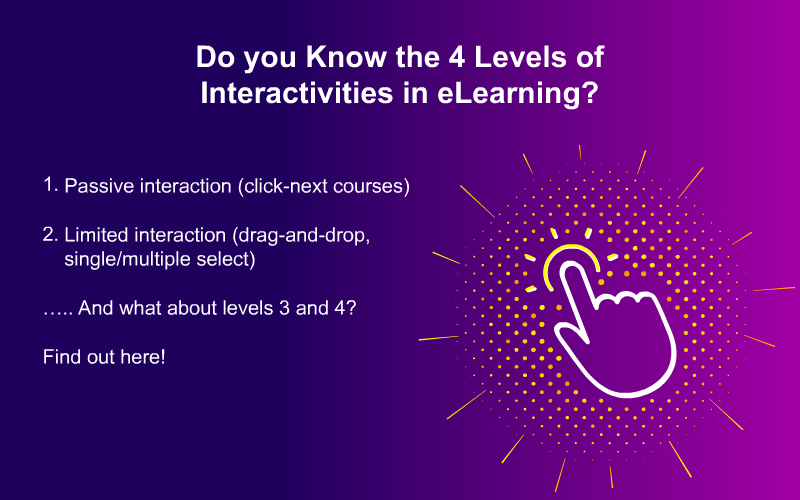Interactivities in Level 2 and Level 3: Limited and Moderate Interactions
This blog will discuss the second and the third levels of interactivities, which are limited and moderate interactions

In my previous blog, I discussed the first level of interaction, passive interaction. Now let me take you through the second and third levels of interactivities.
Level 2: Limited Interaction
Order of content
Though the learner has limited interaction with the course, he is an active participant. The course allows him to navigate to a unit or a slide of his choice as the content is presented in a non-linear fashion.
Level of application
The limited interaction level requires the learner to display his knowledge by applying it in his job. Hence, this targets Bloom’s taxonomy at the third level, which is application.
Type of content
Limited interactivity can be used to teach principles such as compliance training and non-complex business problems. For example, if employees need to be trained on any guidelines they need to adhere to, level 2 interactivity would work.
Instructional strategies
This level of interactivity lays emphasis on application-level objectives. It uses examples, non-examples, case studies, and even simple scenarios. At this level, the course involves some audio with narration and videos along with some animations and transitions. It can also include drag-and-drop and matching activities.
Presentation strategies
This interactivity level accommodates text with graphics and basic multimedia elements such as rollover graphics and narrated animations.
Practice and feedback
Limited interactivity level offers text-based knowledge and identification-based practice to learners. Assessments are through simple quizzes, games, or multiple-choice exercises and feedback is provided along with correct and incorrect answers that helps in reinforcement.
Level 3: Moderate Interaction
Order of content
At this level, the learner has a higher control over the course. He can navigate to any slide of his choice as the course navigation is non-linear.
Level of application
A moderate level helps the learner evaluate a situation and take decisions. This targets the third level of Bloom’s taxonomy, that is, application.
Type of content
Moderate interactivity can be used to teach various interwoven concepts that are needed for decision-making. It involves a problem-based approach where real world business problems that need authentic representation and sophisticated practice are addressed. For example, medical training such as surgeries and flight simulations can be taught through this level of interaction.
Instructional strategies
Moderate interactivity level focuses on knowledge application and transfer. It uses examples, non-examples, case studies, and complex scenarios. It includes software simulations and multiple-choice, drag-and-drop, and other kinds of activities. This level also involves animated videos and customized audio.
Presentation strategies
This interactivity level has text with custom photos and custom graphics. It also accommodates complex and narrated animations. It has advanced multimedia-based presentations as interactive animations.
Practice and feedback
Moderate interactivity level offers complex practice opportunities that include multi-branching exercises. It includes decision and application-based practice along with informative feedback.
In my next blog, the fourth and the highest level of interaction, Enhanced Interaction, will be discussed. See you soon.





